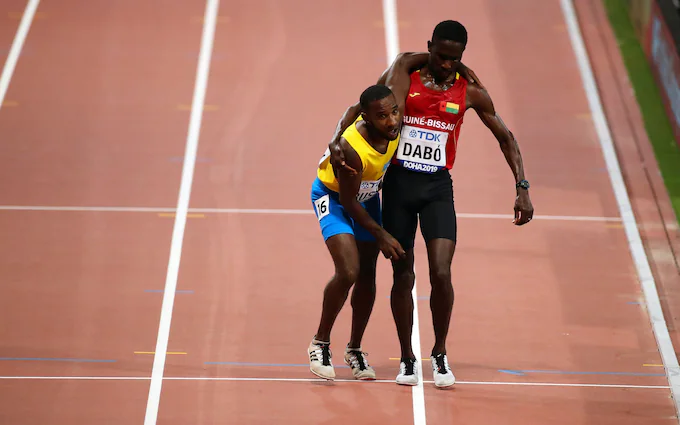

You train hard, recover with intent, and eat clean (maybe even skip a sweet treat… sometimes). Yet your performance plateaus, your energy crashes, and it feels like you’re practicing underwater- sluggish, unfocused, not fully present.
If you’re like me, you probably tried to crack an energy drink or two to fix this problem. Put it down. It may not be a training or caffeine problem. It might just be a fueling problem.
This brings us to Relative Energy Deficiency in Sport, or RED-S, one of the most overlooked causes of plateaus, burnout, and injury in athletes.
The International Olympic Committee (IOC) defines RED-S as the impaired physiological and psychological function caused by low energy availability (LEA). RED-S happens when your energy intake (food) doesn't meet the total energy your body needs for training + recovery + basic function. This energy gap, even if unintentional, starts a chain reaction that affects nearly every system in the body: hormones, bone health, metabolism, and performance.
Energy Availability (EA) is the fuel left over after training
EA = (Energy Intake - Exercise Expenditure)/Fat-Free Mass
RED-S risk happens when EA is below a 30 threshold, and your body will take shortcuts to make up for your shortcomings- lowering resting metabolic rate, suppressing reproductive hormones, and slowing bone turnover. You are trying to maximize performance while putting your body into conservation mode.
Hormonal:
↓ Lower estrogen/testosterone
↓ Less muscle repair & slower recovery
Musculoskeletal:
↓ Bone density
↑ Stress fractures
↓ Collagen turnover
Metabolic:
↓ RMR
↓ Slower glycogen restoration,
↓ Poorer temperature regulation
Cardiovascular:
↓ Reduced endurance capacity
↓ Reduced max heart rate
Neurological:
↑ Increase in fatigue
↑ Increase in brain fog
↓ Loss of focus in competition
Immune:
↑ Higher illness frequency
↑ Prolonged recovery
RED-S doesn’t always show up as weight loss (sorry). More often, it looks like stagnant training numbers, slower sprints, or nagging injuries. A 2024 systematic review found that nearly 45% of competitive athletes show symptoms of low energy availability (LEA).
Those with chronic deficits experienced:
● Decreased aerobic endurance and anaerobic capacity
● Impaired strength and power output
● Slower recovery between sessions
● More frequent soft-tissue injuries and stress fractures
Under-fueling breaks down the body’s repair system. Here’s what the research shows:
●Athletes with LEA have 2-4× higher rates of bone stress injuries compared to those adequately fueled.
● Delayed recovery from micro-trauma and soft-tissue strains due to low collagen synthesis.
● Reduced reaction time and concentration late in games → higher risk of acute injury.
For endurance athletes, low glycogen + low estrogen = a perfect storm for overuse injuries and fatigue fractures. For power athletes, it can mean chronic soreness, poor muscle retention, and missed lifts.
● Persistent fatigue or brain fog
● Unexplained drop in performance
● Recurrent colds, illnesses, or injuries
● Missed or irregular menstrual cycles
● Feeling cold all the time
● Decline in mood or motivation
If these sound familiar, your body is not weak- it’s just asking for fuel!
RED-S is the performance limiter no one talks about- the invisible wall between training hard and training smart. You can't push harder if your body doesn't have fuel to adapt. Your strength, speed, endurance, and reliance depend on one thing: energy availability.
Fuel Smarter. Train Harder.
Mountjoy, M., Burke, L. M., Ackerman, K. E., et al. (2018). IOC consensus statement on Relative Energy Deficiency in Sport (RED-S): 2018 update. British Journal of Sports Medicine, 52(11), 687–697.
Cabre, C. E., Moore, A. M., Smith-Ryan, A. E., & Hackney, A. C. (2023). Relative Energy Deficiency in Sport (RED-S): Scientific, clinical, and practical implications for the female athlete. Journal of Functional Morphology and Kinesiology, 8(1),
Jeppesen, T. D., Hellsten, Y., Melin, A. K., & Hansen, M. (2025). Short-term severe low energy availability in athletes: endocrine and metabolic adaptations. Frontiers in Physiology.
Melin, A., Tornberg, Å. B., Skouby, S., et al. (2019). Energy availability and the female athlete triad in elite endurance athletes. International Journal of Sport Nutrition and Exercise Metabolism, 29(6), 659–668.
Tenforde, A. S., Barrack, M. T., Nattiv, A., & Fredericson, M. (2016). Parallels with the female athlete triad in male athletes. British Journal of Sports Medicine, 50(11), 660–661.
Thomas, D. T., Erdman, K. A., & Burke, L. M. (2016). Position of the Academy of Nutrition and Dietetics, Dietitians of Canada, and the American College of Sports Medicine: Nutrition and athletic performance. Journal of the Academy of Nutrition and Dietetics, 116(3), 501–528.
Frontiers in Sports and Active Living (2024). Patterns of energy availability and carbohydrate intake differentiate RED-S symptoms in female athletes. Frontiers in Sports and Active Living, 6, 1390558.
Systematic Review: Low Energy Availability and RED-S Prevalence in Athletes (2024). PubMed ID: 39485653.